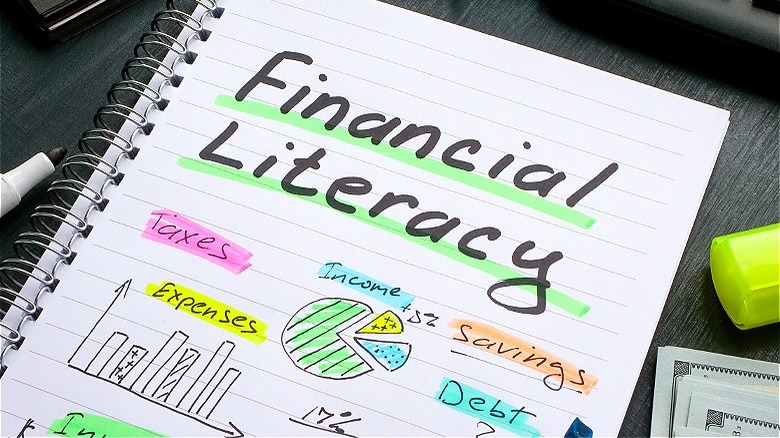Which States Require High Schoolers To Take A Financial Literacy Course?
While financial literacy might not sound like the most exciting thing to dig into, it's ultimately a crucial (and necessary) skill for adults. From finance to savings to risk assessments, having a strong financial foundation can help you better navigate the world. This is especially true as more and more Americans struggle under the burdens of inflation, increased housing prices, and student loan debt. However, even though financial literacy should be as foundational as other topics, it's often left out of crucial educational requirements. From its 2024 data, the World Economic Forum found that just 50% of adults in the United States are considered financially literate. Even worse, there has been a 4% drop since the pandemic.
Even though financial literacy (or the lack thereof) has led many within the younger generations to feel a kind of money phobia — especially when it comes to thinking about or planning for the future — some states are trying to combat this knowledge gap. Currently, 25 states have a requirement in which high school students must take a personal finance class in order to graduate. Note that many of these states have only very recently implemented this course requirement, however, and some won't be fully implemented for several more years.
As of December 2023, only seven states in the United States required high schoolers to take a semester-long personal finance course. Yet, the recent flurry of legislation means an anticipated 23 states should hit that same benchmark in 2028. The graduating classes that will first be positively affected by this course requirement will graduate in 2027 and 2028.
Why are financial literacy courses important?
There's a lot to learn when it comes to finance knowledge, and this can be especially important for high schoolers as they begin their journey to financial independence. According to Ramsay Solution's Students and Money National Research Study, students who took a personal finance course were positively impacted by doing so. Eighty percent of the 76,000 high school students Ramsey surveyed reported opening their own bank account, and two-thirds of them reported actively earning money (with an average monthly income of $243). Best of all, eight in 10 respondents reported creating a monthly budget for themselves.
Some other key factors when it comes to educating high school students is the potential impact this financial knowledge could have on their college choices. Students who took a personal finance class were 23% less likely to plan to use loans in order to pay for college. This means future generations could avoid the pitfalls of excessive student loan debt that have plagued millennials and Gen Zers. Avoiding that debt out of the gate bodes well for younger generations who might also be more wary of other kinds of debt.
According to Bankrate's 2023 annual emergency savings report, 36% of U.S. adults have more credit card debt than emergency savings. This increased debt level can have catastrophic consequences, especially in cases of job loss. Another 68% reported being unlikely to cover even one month's worth of living expenses should they lose their primary income source, while 25% reported having no trusted source for financial guidance.
What's next for financial literacy in high school
It's important to realize that many states technically had financial literacy in their curriculum, but only as add-on education inserted into existing courses rather than stand-alone dedicated classes on the subject. When it comes to "guarantee" states, or states that ensure a full stand-alone course, there are currently only 10 states with fully implemented programs and 15 states that are currently in the process of implementing their programs and requirements. Within the remaining 25 U.S. states that currently don't mandate a financial literacy course, certain local guidelines could include financial literacy education, meaning that varying percentages of a state's graduating class could have some level of personal finance education. It's also worth noting that as of May 2024, there are 33 active legislative bills in 12 states that are specifically focused on implementing stand-alone financial literacy courses.
John Pelletier, director of the Center for Financial Literacy at Champlain College, explained the benefits of the recent surge in course requirements, "In five short years, more than four out of 10 U.S. high school students will be enrolled in schools where a stand-alone, full-semester course in personal finance is required before graduating. That's a 229% increase from 2017." While there's no guarantee that this additional financial education will lead all young people to better financial circumstances, there is a strong connection between financial literacy and overall financial well-being. Best of all, unlike dreaded trigonometry or algebraic equations, high school students will actually be able to answer the question of when they might use their financial education in their everyday lives.


